22 September 2022
War memorial art: iconic works responding to the World Wars
Join us as we analyse some of the iconic pieces of war memorial art produced during or in response to the World Wars.
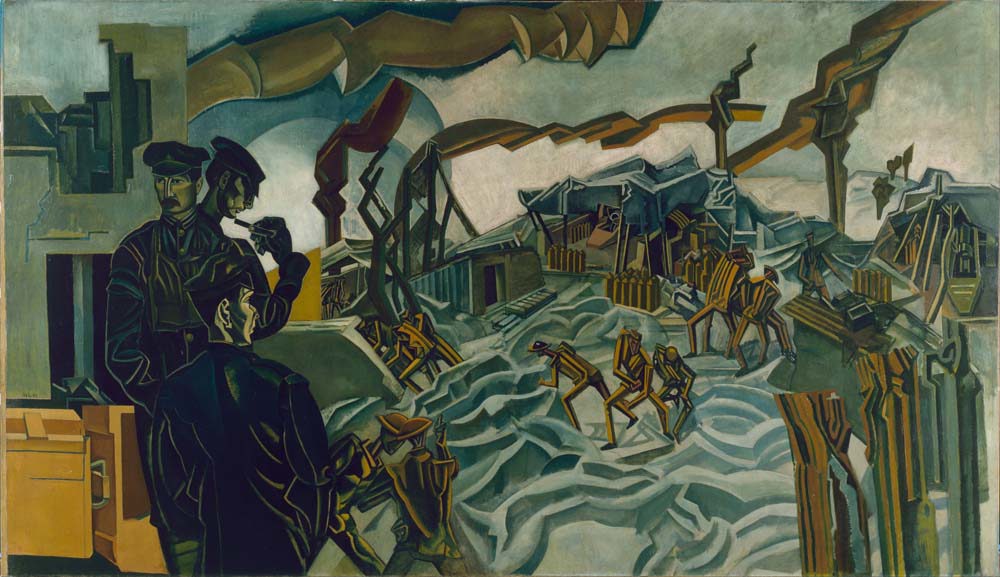
A Battery Shelled, 1919, Wyndham Lewis (Wikimedia Commons)
Why is artwork on war important?
For however long humanity has been fighting wars, it has been recording them visually too.
Art is all about sharing ideas and experiences. As a form of communication, art helps us perceive, understand, and engage with complex concepts, emotions, and ideas.
Very few aspects of human existence are as complex as warfare.
From ancient hieroglyphs adorning Egyptian temples, Roman columns, medieval tapestries, and modern pieces, humans have been exploring war memorial art for millennia.
The human drama at the centre of all conflicts continues to attract and repulse us in equal measure. As such, war and art are inextricably linked.
So, why is war art important? It is valuable for a couple of key reasons:
- It’s useful for visualising battlefields and combat
- It’s valuable for understanding the plight of the men and women involved
- It acts as a propaganda tool for both pro and anti-war factions
- It helps combatants share and process their experiences
- It aids commemoration of war dead
The creatives recording the World Wars left behind a body of work matching the importance of war memorials and cemeteries for commemoration and remembrance.
Why were there official war artists?
War artists exist to artistically portray everything about the conflicts they cover. They put their creative skills to use to depict and interpret the myriad images and sensations warfare throws up.
Artists employed as official war artists could be called on to create works for propaganda purposes, to commemorate casualties and soldiers’ sacrifices, to depict the industrial and manufacturing sides of combat, or to record the human element of the war machine.
Artworks and artists were integrated into the war efforts during the World Wars.
While the British Empire did not immediately create an official war artists programme when the Great War broke out in 1914, it did so two years later.
Sir Muirhead Bone became Britain’s first official war artist of the Great War.
The British authorities wanted to compile a visual record of the war. Many famous artists with wildly differing styles all created works under the auspices of the Department of Information.
By 1918, the role of commissioning war artists had moved to the British War Memorials Committee.
Some of the most famous war artists of World War One include:
- John Nash
- Christopher R. W. Nevinson
- Wyndham Lewis
- Sir Stanley Spencer
- John Singer Sargent
- Eric Kennington
Arts pioneer, and then Director of the National Gallery, Sir Kenneth Clarke made it his mission to create a visual record of the war when World War Two broke out in 1939.
Having seen the devastation caused by the Great War on artistic types, with thousands dying on the frontline, Clarke was determined to protect artists. This extended to protecting their incomes a well as their lives. Many were on the cusp of bankruptcy as total war diminished opportunities for artistic patronage.
Clarke’s response was to set up the War Artist’s Advisory Committee (WAAC) in 1939 under the Ministry of Information. Its aim was to:
Draw up a list of artists qualified to record the war at home and abroad. In co-operation with the Services Departments and other Government Departments...to advise on the selection of artists on this list for war purposes and on the arrangements for their employment.
The multitude of artists involved created war memorial art, commemorative pieces, and slice-of-life works depicting the home front, partly for propaganda, but also to record the war.
Hundreds of artists were given full-time or part-time contracts with the WAAC or had their works collected by the organisation.
By the time of the end of the war in August 1945, the WAAC had acquired over 5,000 pieces of war art. Over Half of the WAAC’s collection is now under the care of the Imperial War Museum.
Official British artists of World War Two include:
- Edward Ardizzone
- Eric Ravilious
- Albert Richards
- John Nash
- John Piper
- S Lowry
Hiring official war artists was not a purely British initiative. Commonwealth member states Australia, New Zealand, Canada, and South Africa all hired official war artists during both world wars.
Their war memorial art is as important as their British counterparts in tracking, recording, and sharing the Commonwealth’s wartime experiences. Take a look at some examples of their work below:
What impact does war have on art?
War memorial art and other types of artistic expression have been moulded by warfare, and vice versa, in several ways:
- To promote war – Carefully curated and selected artworks can hold powerful propaganda value to encourage and inspire others into conflict.
- To oppose war – Brutal depictions of warfare and its effects have been used to reinforce anti-war messages throughout the year.
- To aid in post-war recovery – From being auctioned off to creating funds to help survivors to veterans processing their experience through artistic expression, art has been linked to post-war recovery.
It’s interesting to see shifts in the depiction of warfare during World War One. Gradually, we saw a shift from the heavily stylised, renaissance-inspired pieces from the Victorian era to more abstract and grittier depictions of warfare.
Some of the most iconic pieces of Great War art are not triumphant soldiers gallantly slaying their opponents. Most are of twisted battlefields strewn with corpses, mud, and wire; of gassed, wounded men; of hellscapes where nothing lives.
There were still plenty of classically inspired canvases depicting battlefield action and vistas. However, artists like CRW Nevinson were able to bring the war to life using new schools of art and design.
Either way, the war these artists painted was one of modern brutality.
Several artists would continue to adopt this warts-and-all approach while depicting World War II.
Artists continued to find their truth of their wartime and show it in their works. Often this served a practical purpose.
Did you know that the WAAC organised exhibitions of UK war art in the US prior to America’s 1941-entry into World War Two?
The idea was to tug on US citizens’ heartstrings by showing realistically painted visions of war-smashed Europe. Ultimately, it would take the events of Pearl Harbour to bring the United States into World War Two, but this shows why the Ministry of Information found it important to promote artists’ work.
Art is there to showcase ideals, ideas, conflict and confusion, hope and heartache, and all manner of emotions. War has a huge impact on them, which war-inspired artwork reflects.
Famous war paintings
War art WW1
Let’s look at some iconic or moving paintings created by war artists during WW1.
The Ghosts of Vimy – William Longstaff
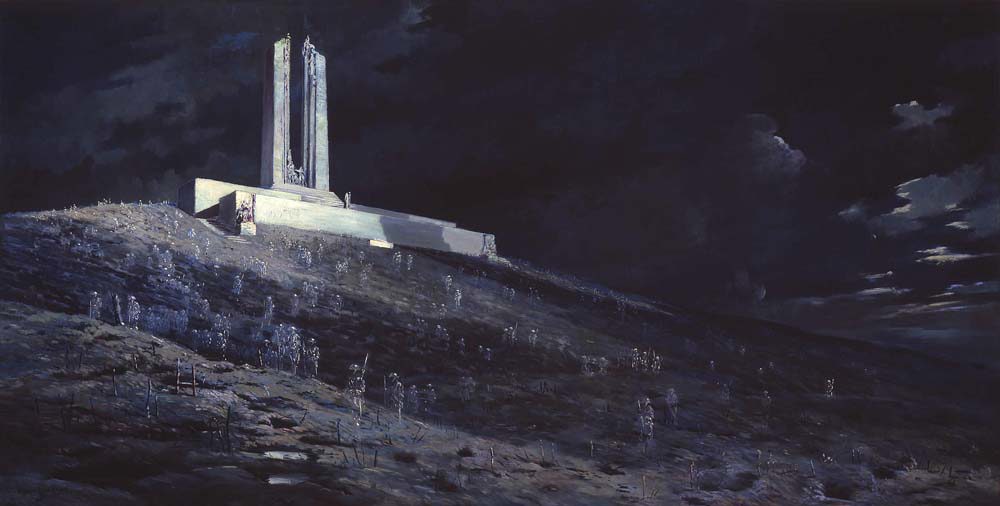
Ghosts of Vimy, 1929, William Longstaff (Wikimedia Commons)
Australian artist William Longstaff produced some of the most evocative war memorial art of World War One.
In this case, it’s literally war memorial art.
The Ghosts of Vimy, painted in 1929, shows a night-time scene high on Vimy Ridge. The Vimy Memorial to Canadian troops, under construction at the time, stands like a shining beacon in the dark night sky. On the ground, spectres of Canadian soldiers ghostly glide towards their lines.
While the monumental architecture gives us a tangible reminder, the ghosts of the soldiers remind us that these were real men who gave their lives.
Vimy was a foundational event for Canada. It marked the first time that all four Canadian divisions on the Western Front fought as a single unit. At great cost, they managed to dislodge heavy German resistance from the top of the ridge in April 1917.
At Vimy, the Canadians had taken more ground and more guns than the British at any point of the war up until that date.
 Image: Menin Gate at Midnight, 1927, William Longstaff (Wikimedia Commons)
Image: Menin Gate at Midnight, 1927, William Longstaff (Wikimedia Commons)
Longstaff would draw on the spectral world in further war memorial art. Menin Gate at Midnight, for instance, demonstrates a sweep of Australian phantoms advancing across the ground outside Ypres.
Hundreds of thousands of Allied soldiers made their way through Menin Gate on their way to battlefields around Ypres. Hundreds of thousands would die fighting here. Longstaff’s ghostly hosts remind us of the human cost of conflict.
Gassed – John Singer Sargent
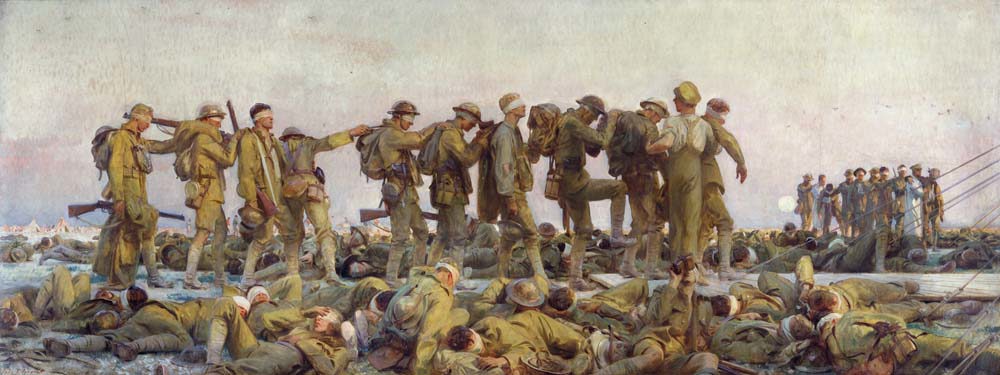
Gassed, John Singer Sergeant, 1919 (Wikimedia Commons)
Gassed is amongst the most iconic pieces of Great War art.
It shows a unit of blindfolded, bedraggled men, each trying to lead the other on, through a field of their fellow wounded. It doesn’t pull any punches.
The men painted have been hit by mustard gas. Gas warfare was common throughout World War One. Mustard gas would leave soldiers with terrible burns all over their bodies, fried lungs, and often blind.
John Singer Sargent, an American ex-pat working in the UK and one of the Edwardian era’s finest portrait artists, created Gassed. He was inspired after seeing the aftermath of a German gas bombardment on the British 2nd and 3rd Infantry divisions during the Second Battle of Arras in 1918.
Sargent was commissioned to paint Gassed as part of the British government’s aborted Hall of Remembrance project. The idea was to create a hall full of commemorative paintings and artworks to remember the war.
Ultimately the project folded, but many of the pieces commissioned, such as Gassed, were still finished.
Gassed puts the human drama of the war front and centre in realistic fashion.
The line of tall soldiers being led to their aid station takes on an almost religious significance. The pale hazy light also gives the painting a woozy feel.
Eagle-eyed viewers may spot the football match being played out in the background, showing men trying to restore some normality to the hellscapes around them.
Over the Top – John Nash

"Over the Top" Artists' Rifles at Marcoing, 1917, John Nash (Wikimedia Commons)
“Over the Top”. 1st Artists’ Rifled at Marcoing, 30th December 1917 is a 1918 painting by war artist John Nash.
It shows British troops of Nash’s unit scrambling out of their trenches, through the snow, to advance on an enemy position. Each soldier is decked out in their thick winter great coats. Nash’s sky is dark with ominous clouds billowing overhead.
Three soldiers are already dead while their comrades grimly advance without looking back.
Nash was actually part of this attack as a member of the 28th Battalion of the Artists’ Rifles. 80 men went over the top at Marcoing. 68 were killed or wounded in the first few minutes of the attack. Nash was one of just 12 of his unit who survived.
It’s an interesting painting. There is an undercurrent of stoicism, with the British soldiers grimly advancing, but not a lot of glory. One’s eyes are immediately drawn to the fallen bodies, while the one visible expression of a living soldier is full of nerves and pensiveness. The men are hunched and cautious, rather than blindingly heroic.
While Nash’s style is more abstract and not 100% naturalistic, it is highly evocative of the mood in the trenches during the last years of the great war.
See below for more evocative images of the Great War created by war artists:
work by second world war artists
War artists from WW2 brought their trying times to vivid life just as their Great War counterparts did decades before. Here’s a quick selection of the artistic works created by war artists between 1939-1945.
Battle of Britain – Paul Nash
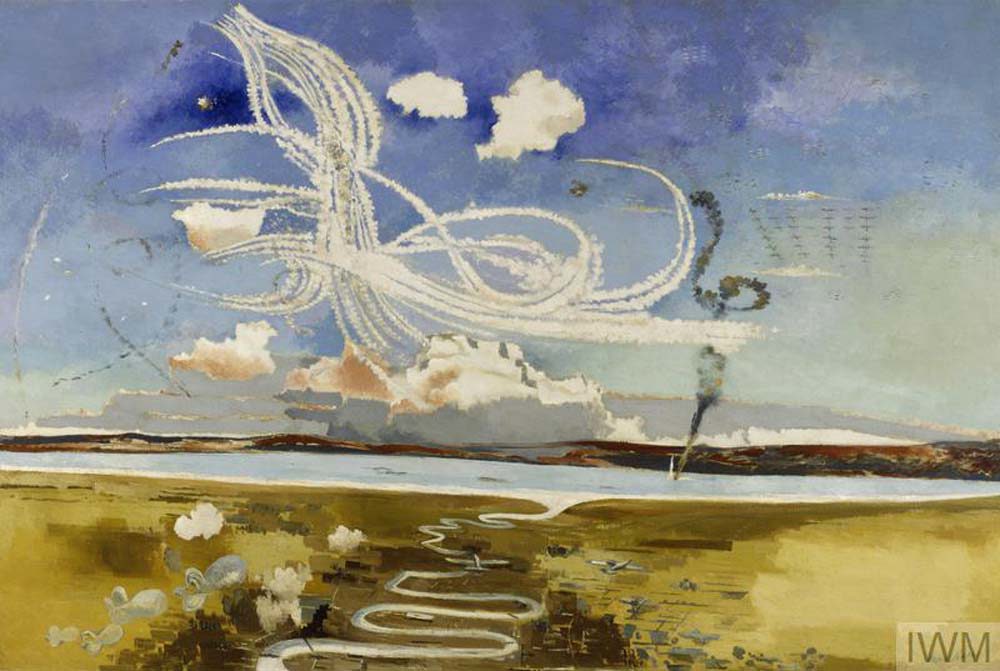
Battle of Britain, 1941 Paul Nash, (© IWM Art.IWM ART LD 1550)
Paul Nash was the older brother of John Nash and like John had seen action in the trenches of World War One.
Like his younger brother, Paul was also an exceptionally talented artist. His work is responsible for pioneering modernism in the UK art scene. His style also creates some of the most evocative, moody pieces of World War Two art.
Take his 1941 painting Battle of Britain for instance.
Paul put his considerable talents as a landscape painter to good use here, depicting a swirling dogfight high above a coastal river. A thick fog of smoky serpentine contrails dominates blue skies while silver planes drift towards the action. Dark clouds build in the background over mainland Europe. In the distance, a flight of Luftwaffe planes advances menacingly.
The chaos and confusion of dogfighting is plain to see in the battle scene. It also presents an interesting juxtaposition in how the RAF and Luftwaffe are depicted here. The Luftwaffe are portrayed as a disciplined, singular unit against the free-flowing heroics of the RAF pilots.
Blitzed Site – L.S Lowry
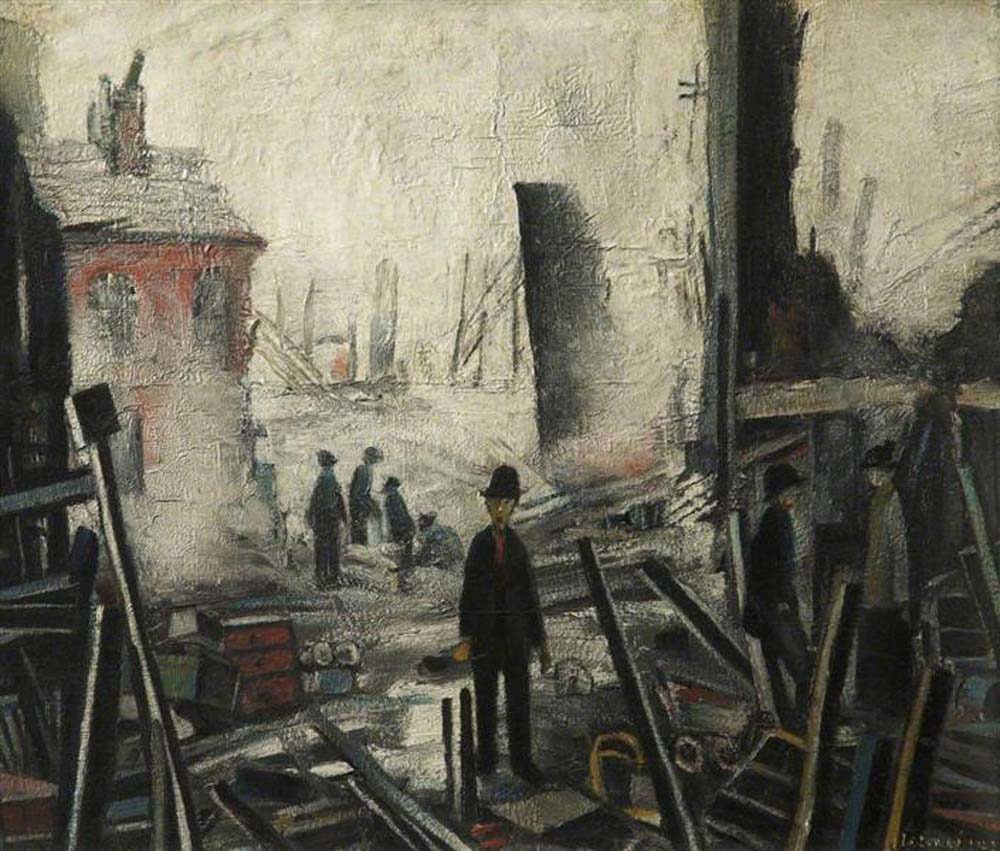
Blitzed Site, 1942, L.S. Lowry (Google Art Project)
L.S Lowry is one of Britain’s most storied artists. His snapshots of working-class life in the industrial north, particularly Manchester and Lancashire communities, are deeply ingrained in the national psyche.
But did you know he was also employed as a war artist by the WAAC?
Lowry served as a firewatcher in Manchester, typically stationed on the roof of a city centre department store. While this allowed him to do his bit by pointing out fires caused by bombing raids, it also afforded him the opportunity to sketch scenes “before the smoke and grime had cleared”.
We often think of the Blitz as a purely London-based affair. This isn’t the case. Major urban centres like Liverpool, Coventry, Southampton, Portsmouth, and Lowry’s Manchester were targeted by German bombers too.
Painted in 1942, Blitzed Site shows that harsh reality. Muted colours, representing that smoke and grime, are matched with splashes of reddish hues to symbolise the bomb damage. Ruins jut out at unnatural angles as despondent figures pick through the rubble.
The central figure of a man in a suit with a red tie and bowler hat has a shocked, traumatised expression. His red tie peaks through the darkness of his silhouette, representing the violence of bombing campaigns.
People all over the world would wake up or come home to such devastating scenes. Lowry’s work reminds us of the civilian cost and experience of World War Two.
The Wehrmacht – Edward Ardizzone

The Wehrmacht, 1945, Edward Ardizzone (© IWM Art.IWM ART LD 5436)
At first glance, the work of Edward Ardizzone’s style may seem a bit too cartoony or simplistic to express the emotions and imagery of a world war. This couldn’t be farther from the truth.
Ardizzone’s work reflects the humanity at the core of World War Two.
This was a human drama played out by human beings after all.
His style lends itself well to homing in and focussing on the more relatable aspects of the war. After all, not all war memorial art can depict sweeping vistas and grinding machinery.
Ardizzone’s The Wehrmacht encapsulates one emotion missing from the other pieces we’ve featured here: defeat.
Painted in May 1945, The Wehrmacht shows a column of defeated German soldiers winding its way along a tree-lined landscape. Some drag behind them wheeled carts holding their meagre belongings. The painting hangs heavy with dejection, despair, and defeat, the soldiers a mass of subdued greys.
It’s an interesting treatment of a defeated enemy. Gone are triumphal poses and bombastic imagery of yesteryear. All that remains is a group of wounded, tired, depressed men who have seen their world come crashing down. It isn’t a boastful piece, but The Wehrmacht ably demonstrates Ardizzone’s canny ability to encapsulate human emotion in his artwork.
See below for a further selection of works from World War Two war artists:
War art - drawings, photography, and sculpture
Of course, war art is not limited to just painting. Drawings, photography, and sculpture give artists other outlets for expression to capture the feelings, sites, and aesthetics of warfare.
 Image: Into the Jaws of Death, 1944, Robert Capa (Wikimedia Commons)
Image: Into the Jaws of Death, 1944, Robert Capa (Wikimedia Commons)
In terms of photography, perhaps Robert Capa is the most well-regarded World War photographer. His black and white images have come to define the conflict, particularly his shots of Omaha Beach and the D-Day landings.
Looking to World War One now, Ernest Brook’s work demands attention.
Brooks was the first official war photographer employed by the British government. His images of Tommies in the trenches, often silhouetted against foreboding battlefield skies, brought home the realities of a modern war to many at home.
The collective mental images we have of men in trenches, going over the top through No Man’s Land, or struggling through everyday life at the front, are heavily influenced by what Brooks’ camera captured.

The Battle of Passchendaele, July-Nov 1917, 1917, Ernest Brookes (Wikimedia Commons)
Sculpture, from the abstract to the naturalistic, has been employed as a war memorial tool for time immemorial. Think of the Egyptian reliefs of Rameses II’s victories or Trajan’s Column in Rome. This was true of World War Artists too.
 Image: The Battle of Ypres, 1914: The Worcesters at Gheluvelt, 1918, Charles Sergeant Jagger (© IWM Art.IWM ART LD 2287)
Image: The Battle of Ypres, 1914: The Worcesters at Gheluvelt, 1918, Charles Sergeant Jagger (© IWM Art.IWM ART LD 2287)
After World War One, war artists were commissioned to provide sculptural reliefs for the planned Hall of Remembrance. The Hall was never built, but we do have some surviving examples of reliefs created for it.
The Battle of Ypres, 1914: The Worcesters at Gheluvelt from Charles Sergeant Jagger is one such example.
Created in stone, The Battle of Ypres, 1914: The Worcesters at Gheluvelt shows soldiers of the Worcesters engaged in hand-to-hand combat with German assailants during the Battle for Gheluvelt.
A gap in the British lines around Ypres had been formed and the Worcesters were brought in to fill it. The actions of the Worcesters in closing the gap in the line around Ypres were decisive and helped protect the city, and ultimately the Channel Ports, in the war’s crucial opening stages.
Their heroism is reflected in the sculpture, with the men all lantern-jawed and rugged. This piece has much in common with Roman and Greek triumphal masonry of the type you’d see adoring arches and temples.
Sculpture also adorns some of our memorials at CWGC, including World War One memorials. Take the Naval Memorials at Portsmouth or Plymouth for example. These feature sculpted statues of naval personnel supplied by artists Henry Poole, Charles Wheeler, William McMillan, and Esmond Burton.
Remember Sir Muirhead Bone, Britain’s first official war artist? He was a draughtsman by trade. That means he dealt with drawings.
The technical complexity of modern warfare, with its factories, cranes, and machinery, was captured by Bone’s pencil. According to biographers, Bone relished the challenge of capturing industrial scenes but was also adept at recording the scenes of blasted battlefields, razed buildings, and the general landscapes of the Western Front.
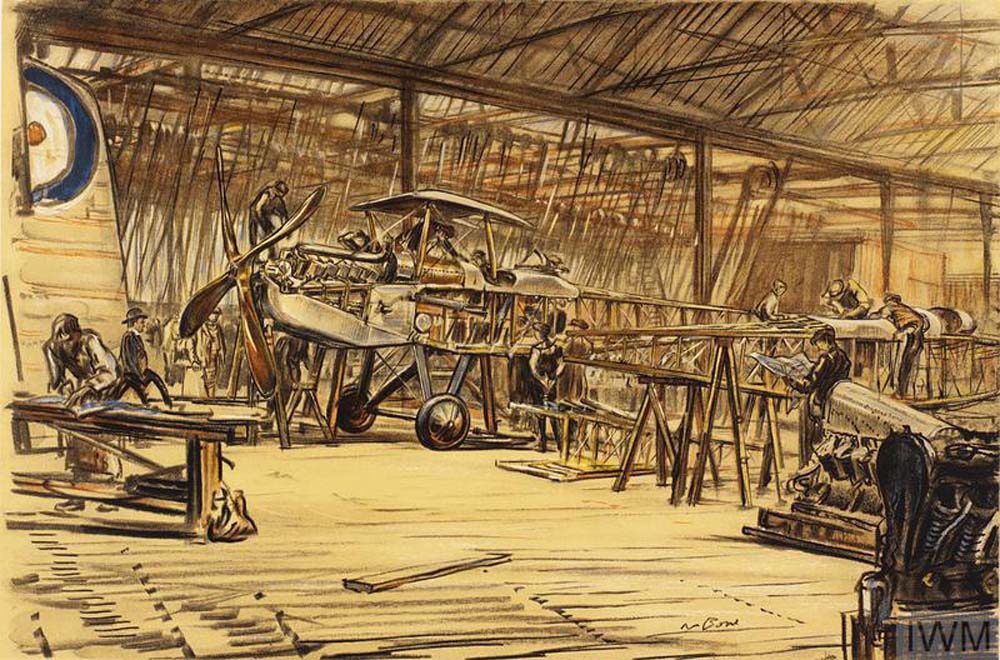
Erecting Aeroplanes, 1918, Sir Muirhead Bone (© IWM Art.IWM REPRO 000684 20)
Discover more stories of war artists and more with the CWGC
Learn more about the men and women of the world wars with our Find War Dead tool.
You’ll be able to discover more about the 1.7m Commonwealth casualties we commemorate and who may have been inked, etched, or painted in iconic war memorial art. Discover their stories today.
Also, don’t forget to visit our sites! See the sculpture and artwork we incorporate into war memorials and cemeteries in person.










